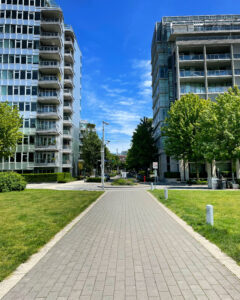History 3991 excercise 1
August 8, 2022 By: Mathew Semograd
Location: 75 West 1st Avenue, Vancouver, BC, Canada

Mathew Semograd
Norman Fennema
June 1, 2022
History 3991
Local Environmental History
Exercise 1: Examining False Creek and Olympic Village
The neighbourhood I currently live in is Olympic Village which is part of False Creek in Vancouver just south of downtown. My building that I live in is one of the buildings athletes used during the 2010 Winter Olympics in Vancouver. The area has many parks, green ways, dog parks, and a pedestrian walkway along the sea wall that goes all the way down False Creek towards Kitsilano Beach.
False Creek and the village never used to look the way it does and the people who originally settled in the area were not Europeans. The first settlements of people came to the area sometime around 8,000 to 10,000 years ago who were Tsleil-Waututh, according to Wikipedia. This settlement began sometime after the retreat of the Sumas Glacier. The Coast Salish people who settled in the now Vancouver area, including False Creek, arrived almost 5,000 years before salmon were swimming in the rivers in and around the area.
Prior to the settlement of Europeans in the area, False Creek extended all the to where Clark Drive currently is and the creek itself was a series of sand bars, according to Wikipedia. False creek was once abundant with sea asparagus, berries, clams, oysters and wild mushrooms that many aboriginal peoples used to eat. However as European settlements began in the area and industrialization increased via the industrial revolution, False Creek became very polluted from industries such as ship building, rail yards and lumber mills. Other industries such as steel plants also settled in the area. The environmental impact of the industries was huge and forever changed the area. It also forced the aboriginal people in the area to leave due to expansion of industry, pollution and segregation.
As industry began to leave the area, false creek began to deteriorate and become rather unsightly. According to Wikipedia, in 1968 Walter Hardwick who was elected to city council led a team to help reshape Granville island and False Creek and help clean the area and increase development of clean, renewable city infrastructure to help the area become livable. The North side False Creek really began to change and become a more livable area, especially with the incoming Expo 86’. Since Expo 86’ land around False Creek has been bought and sold to the city and development companies to build condos and increase urban density. On December 1st 1998 the city council of Vancouver adopted the “Blue Ways Policy and Guidelines” to help clean the area up and keep the environment in mind when development is occurring in the area.
Since False Creek has been cleaned up and more environmental measures have been put in place, many natural wildlife has returned to the area, including many sea birds and even whales. This is a huge improvement from what False Creek used to be in the 50’s and 60’s and today I notice when I walk around the Olympic Village, there are many parks, green areas, small creeks and I have even seen turtles in the creeks around the village which shows that while the environment was damaged by industrial development, with help from us and keeping the area clean, the environment can in fact come back and be as good as it once was.
I do believe that today the Olympic village is a good example of a ‘green neighbourhood’. My building, like many others in the village has multiple green roofs with access for residents to use the green roofs but also the village itself has many walkways and is very pedestrian friendly. There are many amenities in the village including bars, restaurants, cafes and other shops that help keep residents nearby and use less vehicles to move around. Two Sky Trains are close by which increase public transportation and reduce the need for cars. If I were to grade the false creek area and Olympic Village, I would give it a B+. I say this because I know there is still room for improvement, such as increased electric vehicle charging stations that should be placed in the village, as there are only 3 right now and also perhaps a community garden to help residents grow their own food and become more sustainable but also to teach future generations the importance of the environment and understanding of nature in the area.
References
“History of False Creek”, https://en.wikipedia.org/wiki/False_Creek ,2022.
“City of Vancouver” https://vancouver.ca/files/cov/false-creek-south-history-and-context-workshop-presentation.pdf , 2022.